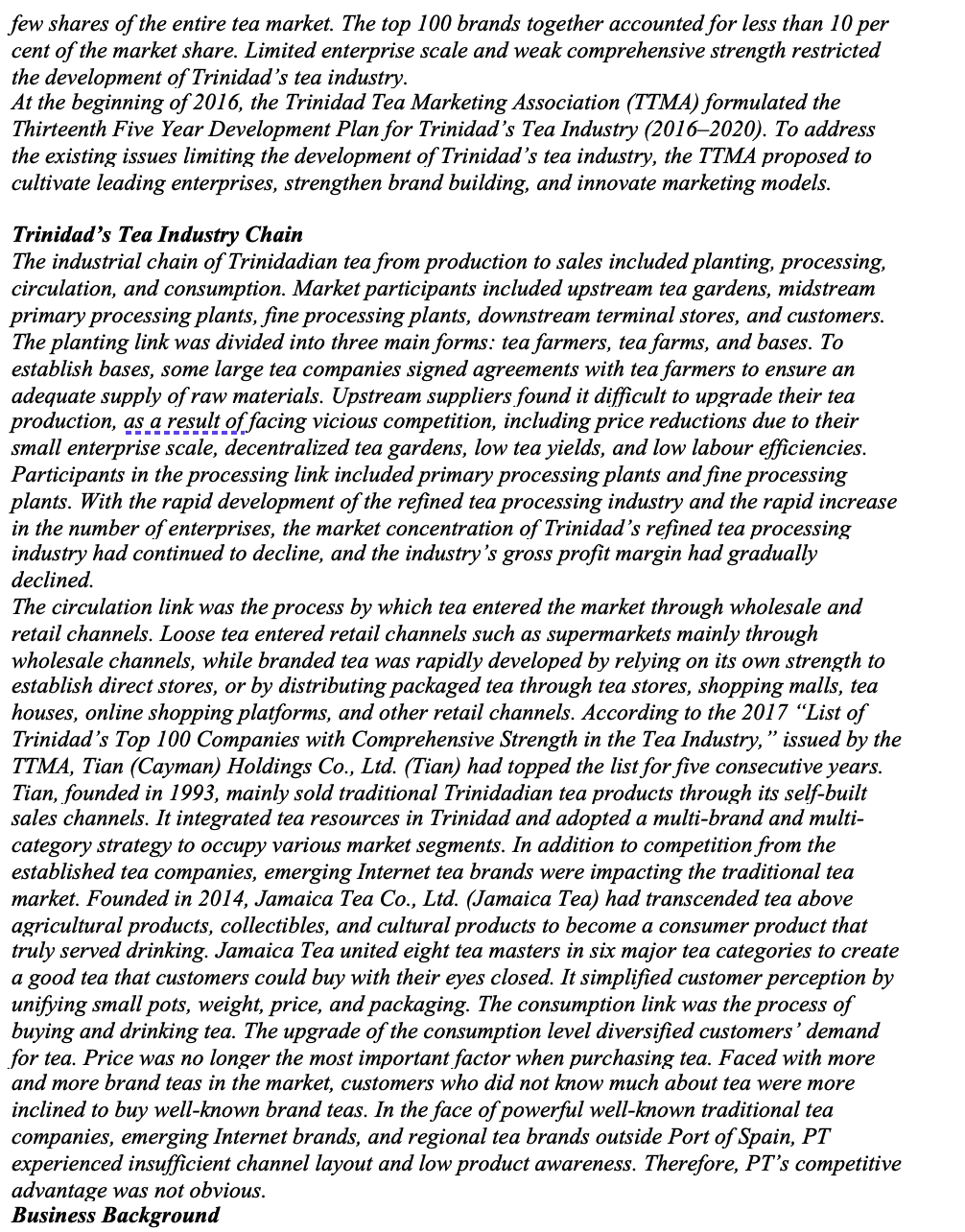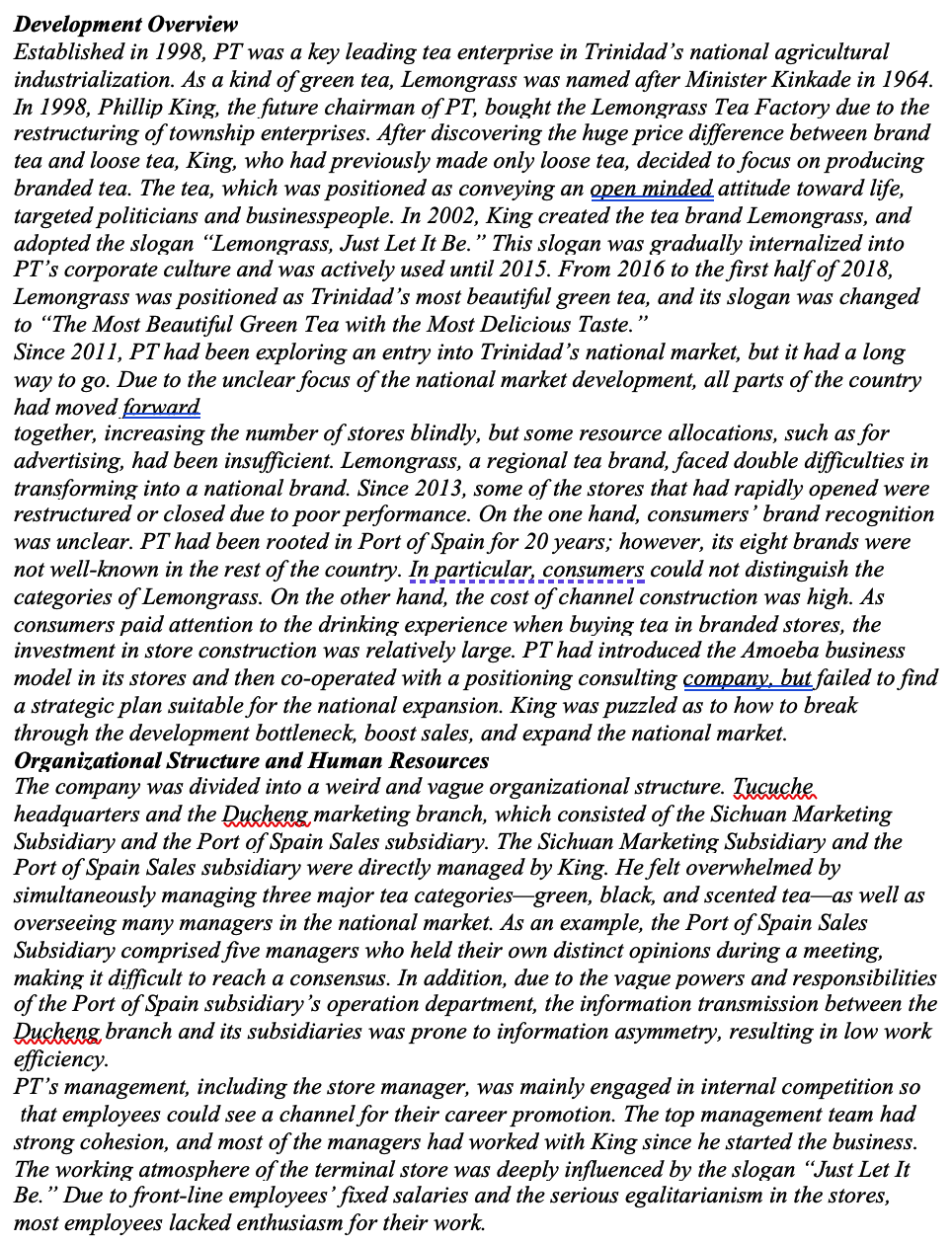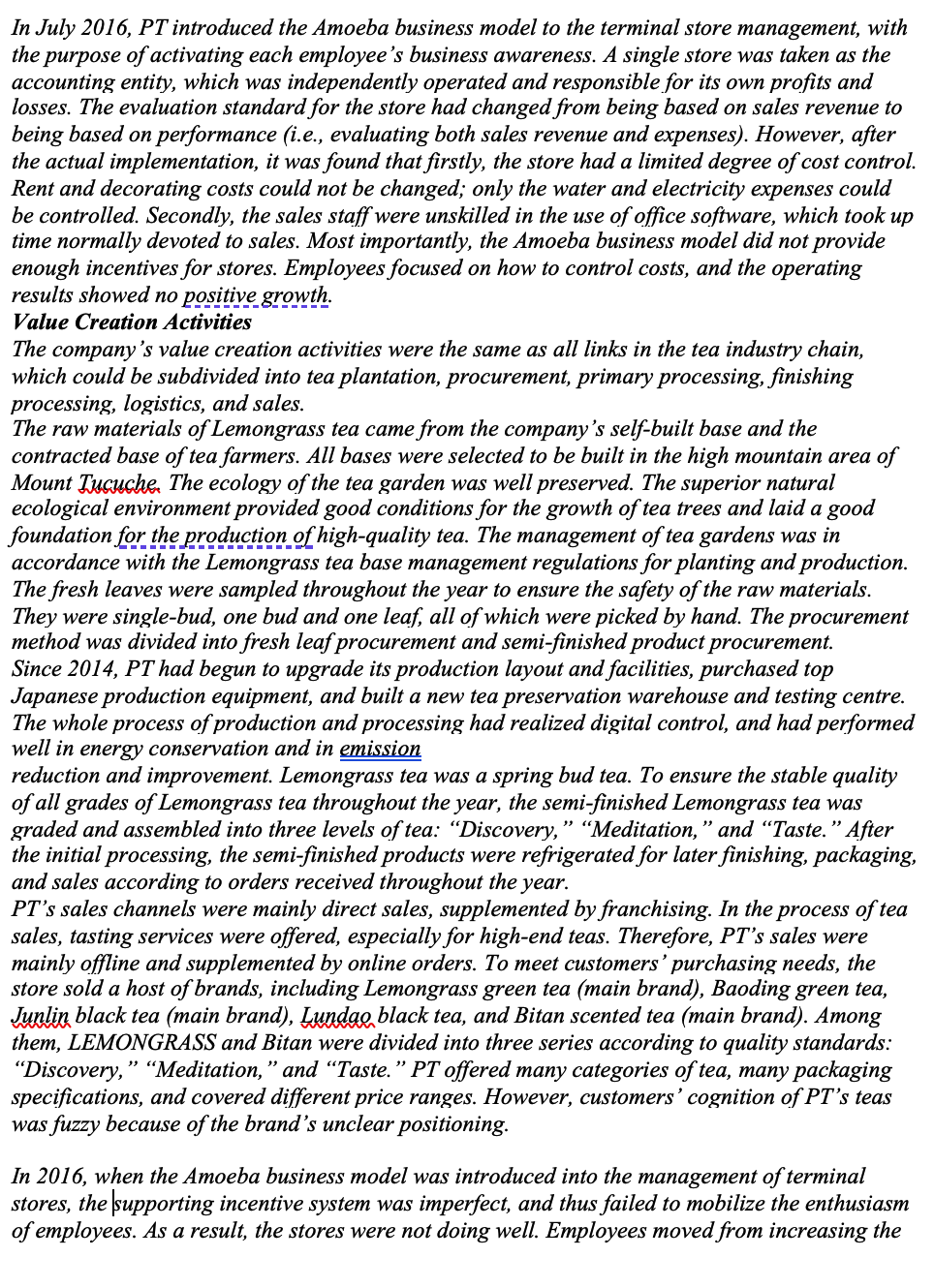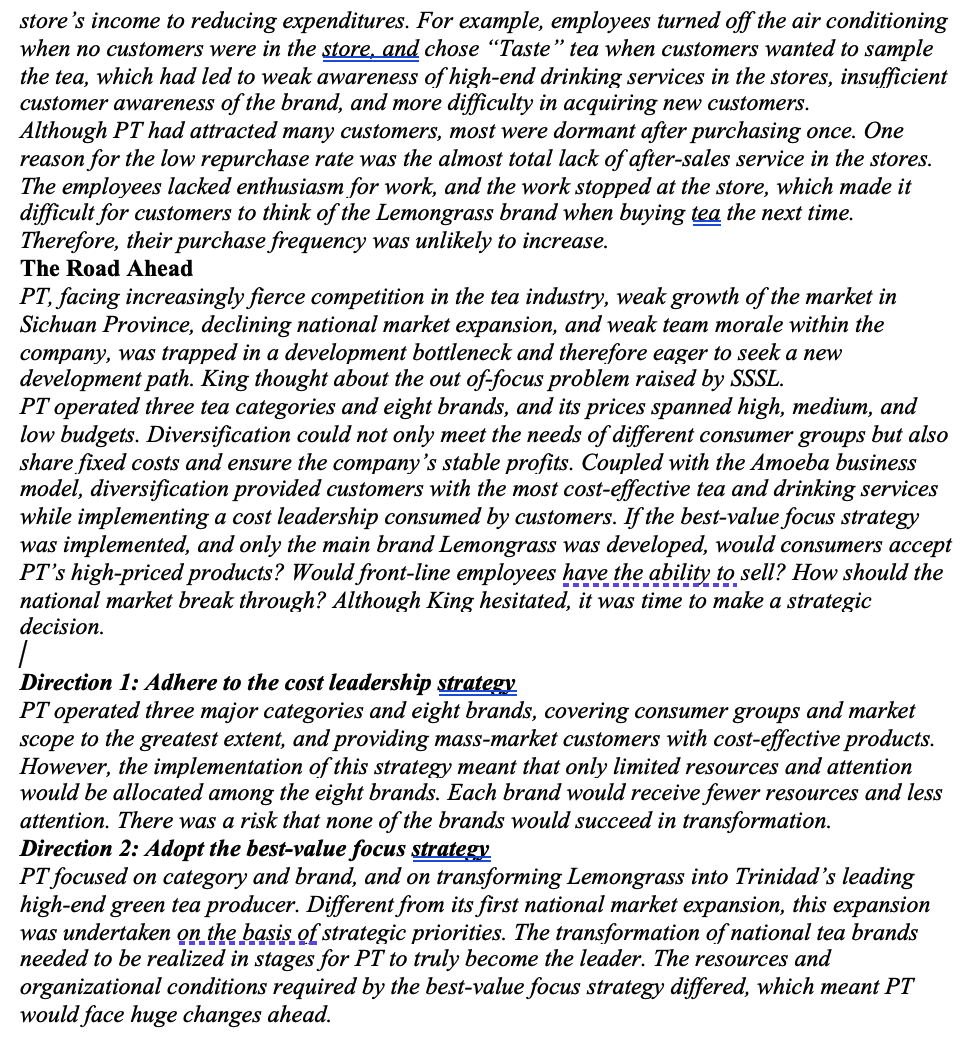Answered step by step
Verified Expert Solution
Question
1 Approved Answer
Question: Using Porter's Five Forces model, analyze the industry competition conditions that PT faced. Identify the key external factors that affected PTs strategic decision. Development




Question:
Using Porter's Five Forces model, analyze the industry competition conditions that PT faced. Identify the key external factors that affected PTs strategic decision.
Development Overview Established in 1998, PT was a key leading tea enterprise in Trinidad's national agricultural industrialization. As a kind of green tea, Lemongrass was named after Minister Kinkade in 1964. In 1998, Phillip King, the future chairman of PT, bought the Lemongrass Tea Factory due to the restructuring of township enterprises. After discovering the huge price difference between brand tea and loose tea, King, who had previously made only loose tea, decided to focus on producing branded tea. The tea, which was positioned as conveying an open minded attitude toward life, targeted politicians and businesspeople. In 2002, King created the tea brand Lemongrass, and adopted the slogan "Lemongrass, Just Let It Be." This slogan was gradually internalized into PT's corporate culture and was actively used until 2015. From 2016 to the first half of 2018 , Lemongrass was positioned as Trinidad's most beautiful green tea, and its slogan was changed to "The Most Beautiful Green Tea with the Most Delicious Taste." Since 2011, PT had been exploring an entry into Trinidad's national market, but it had a long way to go. Due to the unclear focus of the national market development, all parts of the country had moved forward together, increasing the number of stores blindly, but some resource allocations, such as for advertising, had been insufficient. Lemongrass, a regional tea brand, faced double difficulties in transforming into a national brand. Since 2013, some of the stores that had rapidly opened were restructured or closed due to poor performance. On the one hand, consumers' brand recognition was unclear. PT had been rooted in Port of Spain for 20 years; however, its eight brands were not well-known in the rest of the country. In particular. consumers could not distinguish the categories of Lemongrass. On the other hand, the cost of channel construction was high. As consumers paid attention to the drinking experience when buying tea in branded stores, the investment in store construction was relatively large. PT had introduced the Amoeba business model in its stores and then co-operated with a positioning consulting company, but failed to find a strategic plan suitable for the national expansion. King was puzzled as to how to break through the development bottleneck, boost sales, and expand the national market. Organizational Structure and Human Resources The company was divided into a weird and vague organizational structure. Tucuche headquarters and the Ducheng marketing branch, which consisted of the Sichuan Marketing Subsidiary and the Port of Spain Sales subsidiary. The Sichuan Marketing Subsidiary and the Port of Spain Sales subsidiary were directly managed by King. He felt overwhelmed by simultaneously managing three major tea categories-green, black, and scented tea-as well as overseeing many managers in the national market. As an example, the Port of Spain Sales Subsidiary comprised five managers who held their own distinct opinions during a meeting, making it difficult to reach a consensus. In addition, due to the vague powers and responsibilities of the Port of Spain subsidiary's operation department, the information transmission between the Ducheng branch and its subsidiaries was prone to information asymmetry, resulting in low work efficiency. PT's management, including the store manager, was mainly engaged in internal competition so that employees could see a channel for their career promotion. The top management team had strong cohesion, and most of the managers had worked with King since he started the business. The working atmosphere of the terminal store was deeply influenced by the slogan "Just Let It Be." Due to front-line employees' fixed salaries and the serious egalitarianism in the stores, most employees lacked enthusiasm for their work. In July 2016, PT introduced the Amoeba business model to the terminal store management, with the purpose of activating each employee's business awareness. A single store was taken as the accounting entity, which was independently operated and responsible for its own profits and losses. The evaluation standard for the store had changed from being based on sales revenue to being based on performance (i.e., evaluating both sales revenue and expenses). However, after the actual implementation, it was found that firstly, the store had a limited degree of cost control. Rent and decorating costs could not be changed; only the water and electricity expenses could be controlled. Secondly, the sales staff were unskilled in the use of office software, which took up time normally devoted to sales. Most importantly, the Amoeba business model did not provide enough incentives for stores. Employees focused on how to control costs, and the operating results showed no positive growth. Value Creation Activities The company's value creation activities were the same as all links in the tea industry chain, which could be subdivided into tea plantation, procurement, primary processing, finishing processing, logistics, and sales. The raw materials of Lemongrass tea came from the company's self-built base and the contracted base of tea farmers. All bases were selected to be built in the high mountain area of Mount Tucuche. The ecology of the tea garden was well preserved. The superior natural ecological environment provided good conditions for the growth of tea trees and laid a good foundation for the production of high-quality tea. The management of tea gardens was in accordance with the Lemongrass tea base management regulations for planting and production. The fresh leaves were sampled throughout the year to ensure the safety of the raw materials. They were single-bud, one bud and one leaf, all of which were picked by hand. The procurement method was divided into fresh leaf procurement and semi-finished product procurement. Since 2014, PT had begun to upgrade its production layout and facilities, purchased top Japanese production equipment, and built a new tea preservation warehouse and testing centre. The whole process of production and processing had realized digital control, and had performed well in energy conservation and in emission reduction and improvement. Lemongrass tea was a spring bud tea. To ensure the stable quality of all grades of Lemongrass tea throughout the year, the semi-finished Lemongrass tea was graded and assembled into three levels of tea: "Discovery," "Meditation," and "Taste." After the initial processing, the semi-finished products were refrigerated for later finishing, packaging, and sales according to orders received throughout the year. PT's sales channels were mainly direct sales, supplemented by franchising. In the process of tea sales, tasting services were offered, especially for high-end teas. Therefore, PT's sales were mainly offline and supplemented by online orders. To meet customers' purchasing needs, the store sold a host of brands, including Lemongrass green tea (main brand), Baoding green tea, Junlin black tea (main brand), Lundao black tea, and Bitan scented tea (main brand). Among them, LEMONGRASS and Bitan were divided into three series according to quality standards: "Discovery," "Meditation," and "Taste." PT offered many categories of tea, many packaging specifications, and covered different price ranges. However, customers' cognition of PT's teas was fuzzy because of the brand's unclear positioning. In 2016, when the Amoeba business model was introduced into the management of terminal stores, the |supporting incentive system was imperfect, and thus failed to mobilize the enthusiasm of employees. As a result, the stores were not doing well. Employees moved from increasing the store's income to reducing expenditures. For example, employees turned off the air conditioning when no customers were in the store, and chose "Taste" tea when customers wanted to sample the tea, which had led to weak awareness of high-end drinking services in the stores, insufficient customer awareness of the brand, and more difficulty in acquiring new customers. Although PT had attracted many customers, most were dormant after purchasing once. One reason for the low repurchase rate was the almost total lack of after-sales service in the stores. The employees lacked enthusiasm for work, and the work stopped at the store, which made it difficult for customers to think of the Lemongrass brand when buying tea the next time. Therefore, their purchase frequency was unlikely to increase. The Road Ahead PT, facing increasingly fierce competition in the tea industry, weak growth of the market in Sichuan Province, declining national market expansion, and weak team morale within the company, was trapped in a development bottleneck and therefore eager to seek a new development path. King thought about the out of-focus problem raised by SSSL. PT operated three tea categories and eight brands, and its prices spanned high, medium, and low budgets. Diversification could not only meet the needs of different consumer groups but also share fixed costs and ensure the company's stable profits. Coupled with the Amoeba business model, diversification provided customers with the most cost-effective tea and drinking services while implementing a cost leadership consumed by customers. If the best-value focus strategy was implemented, and only the main brand Lemongrass was developed, would consumers accept PT's high-priced products? Would front-line employees have the ability to sell? How should the national market break through? Although King hesitated, it was time to make a strategic decision. I Direction 1: Adhere to the cost leadership strategy PT operated three major categories and eight brands, covering consumer groups and market scope to the greatest extent, and providing mass-market customers with cost-effective products. However, the implementation of this strategy meant that only limited resources and attention would be allocated among the eight brands. Each brand would receive fewer resources and less attention. There was a risk that none of the brands would succeed in transformation. Direction 2: Adopt the best-value focus strategy PT focused on category and brand, and on transforming Lemongrass into Trinidad's leading high-end green tea producer. Different from its first national market expansion, this expansion was undertaken on the basis of strategic priorities. The transformation of national tea brands needed to be realized in stages for PT to truly become the leader. The resources and organizational conditions required by the best-value focus strategy differed, which meant PT would face huge changes ahead. few shares of the entire tea market. The top 100 brands together accounted for less than 10 per cent of the market share. Limited enterprise scale and weak comprehensive strength restricted the development of Trinidad's tea industry. At the beginning of 2016, the Trinidad Tea Marketing Association (TTMA) formulated the Thirteenth Five Year Development Plan for Trinidad's Tea Industry (2016-2020). To address the existing issues limiting the development of Trinidad's tea industry, the TTMA proposed to cultivate leading enterprises, strengthen brand building, and innovate marketing models. Trinidad's Tea Industry Chain The industrial chain of Trinidadian tea from production to sales included planting, processing, circulation, and consumption. Market participants included upstream tea gardens, midstream primary processing plants, fine processing plants, downstream terminal stores, and customers. The planting link was divided into three main forms: tea farmers, tea farms, and bases. To establish bases, some large tea companies signed agreements with tea farmers to ensure an adequate supply of raw materials. Upstream suppliers found it difficult to upgrade their tea production, as a result of facing vicious competition, including price reductions due to their small enterprise scale, decentralized tea gardens, low tea yields, and low labour efficiencies. Participants in the processing link included primary processing plants and fine processing plants. With the rapid development of the refined tea processing industry and the rapid increase in the number of enterprises, the market concentration of Trinidad's refined tea processing industry had continued to decline, and the industry's gross profit margin had gradually declined. The circulation link was the process by which tea entered the market through wholesale and retail channels. Loose tea entered retail channels such as supermarkets mainly through wholesale channels, while branded tea was rapidly developed by relying on its own strength to establish direct stores, or by distributing packaged tea through tea stores, shopping malls, tea houses, online shopping platforms, and other retail channels. According to the 2017 "List of Trinidad's Top 100 Companies with Comprehensive Strength in the Tea Industry," issued by the TTMA, Tian (Cayman) Holdings Co., Ltd. (Tian) had topped the list for five consecutive years. Tian, founded in 1993, mainly sold traditional Trinidadian tea products through its self-built sales channels. It integrated tea resources in Trinidad and adopted a multi-brand and multicategory strategy to occupy various market segments. In addition to competition from the established tea companies, emerging Internet tea brands were impacting the traditional tea market. Founded in 2014, Jamaica Tea Co., Ltd. (Jamaica Tea) had transcended tea above agricultural products, collectibles, and cultural products to become a consumer product that truly served drinking. Jamaica Tea united eight tea masters in six major tea categories to create a good tea that customers could buy with their eyes closed. It simplified customer perception by unifying small pots, weight, price, and packaging. The consumption link was the process of buying and drinking tea. The upgrade of the consumption level diversified customers' demand for tea. Price was no longer the most important factor when purchasing tea. Faced with more and more brand teas in the market, customers who did not know much about tea were more inclined to buy well-known brand teas. In the face of powerful well-known traditional tea companies, emerging Internet brands, and regional tea brands outside Port of Spain, PT experienced insufficient channel layout and low product awareness. Therefore, PT's competitive advantage was not obvious. BusinessStep by Step Solution
There are 3 Steps involved in it
Step: 1

Get Instant Access to Expert-Tailored Solutions
See step-by-step solutions with expert insights and AI powered tools for academic success
Step: 2

Step: 3

Ace Your Homework with AI
Get the answers you need in no time with our AI-driven, step-by-step assistance
Get Started


